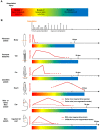Hydrogen Peroxide and Redox Regulation of Developments
- PMID: 30404180
- PMCID: PMC6262372
- DOI: 10.3390/antiox7110159
Hydrogen Peroxide and Redox Regulation of Developments
Abstract
Reactive oxygen species (ROS), which were originally classified as exclusively deleterious compounds, have gained increasing interest in the recent years given their action as bona fide signalling molecules. The main target of ROS action is the reversible oxidation of cysteines, leading to the formation of disulfide bonds, which modulate protein conformation and activity. ROS, endowed with signalling properties, are mainly produced by NADPH oxidases (NOXs) at the plasma membrane, but their action also involves a complex machinery of multiple redox-sensitive protein families that differ in their subcellular localization and their activity. Given that the levels and distribution of ROS are highly dynamic, in part due to their limited stability, the development of various fluorescent ROS sensors, some of which are quantitative (ratiometric), represents a clear breakthrough in the field and have been adapted to both ex vivo and in vivo applications. The physiological implication of ROS signalling will be presented mainly in the frame of morphogenetic processes, embryogenesis, regeneration, and stem cell differentiation. Gain and loss of function, as well as pharmacological strategies, have demonstrated the wide but specific requirement of ROS signalling at multiple stages of these processes and its intricate relationship with other well-known signalling pathways.
Keywords: H2O2; adult stem cells; development; metazoan; redox signalling; regeneration.
Conflict of interest statement
The authors declare no conflict of interest.
Figures



References
-
- Manda-Handzlik A., Demkow U. Neutrophils: The Role of Oxidative and Nitrosative Stress in Health and Disease. Adv. Exp. Med. Biol. 2015;857:51–60. - PubMed
Publication types
LinkOut - more resources
Full Text Sources
Molecular Biology Databases

